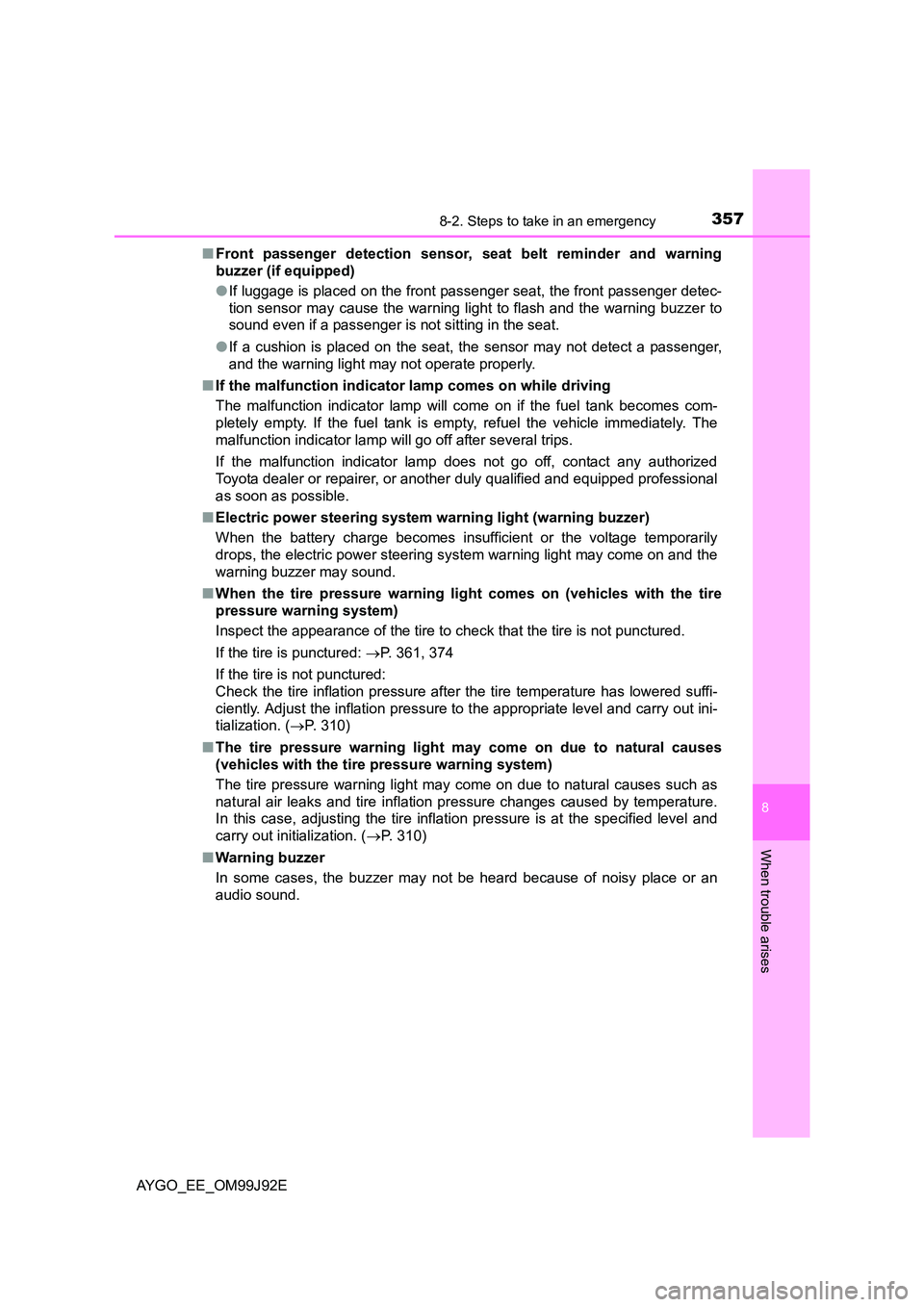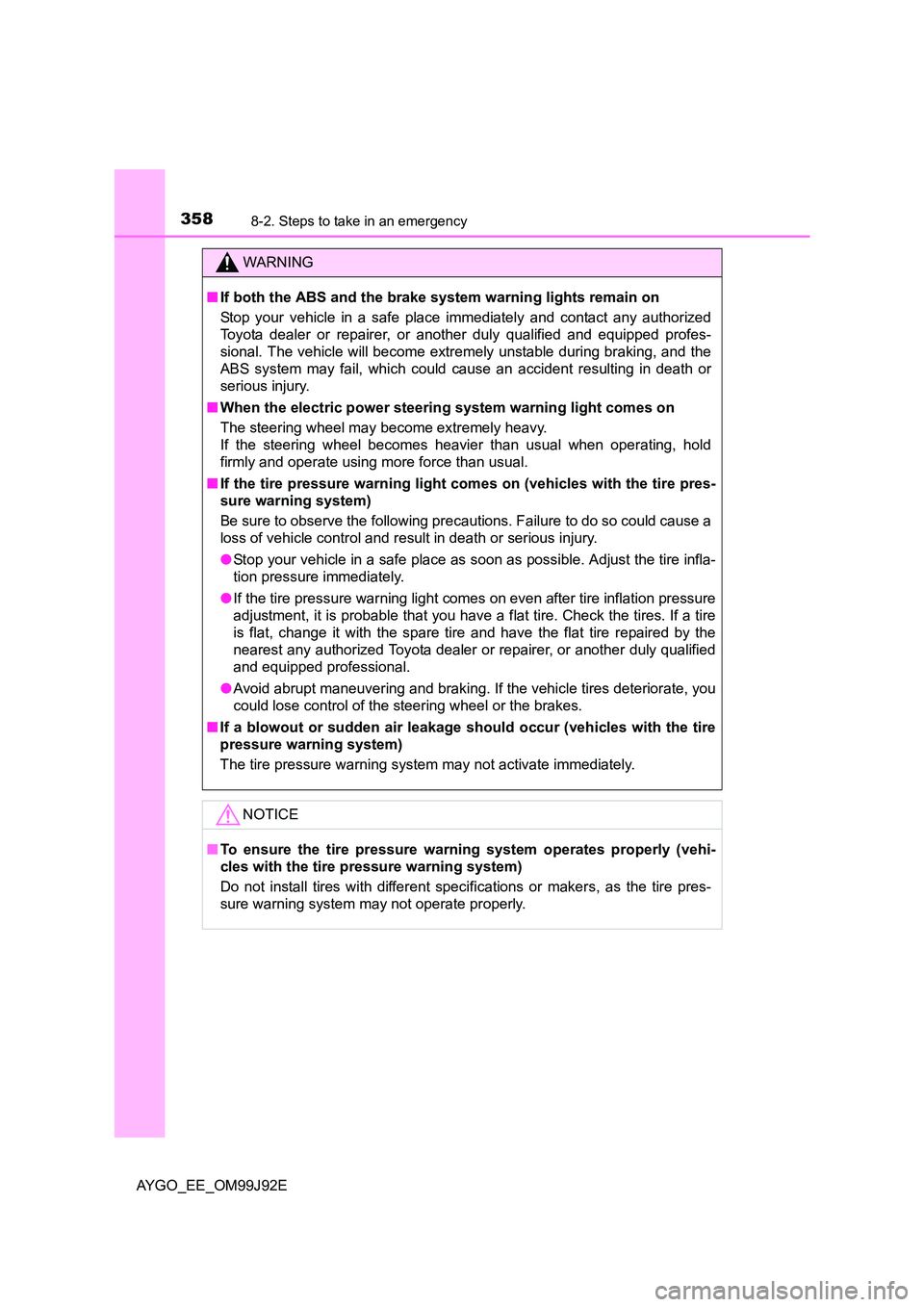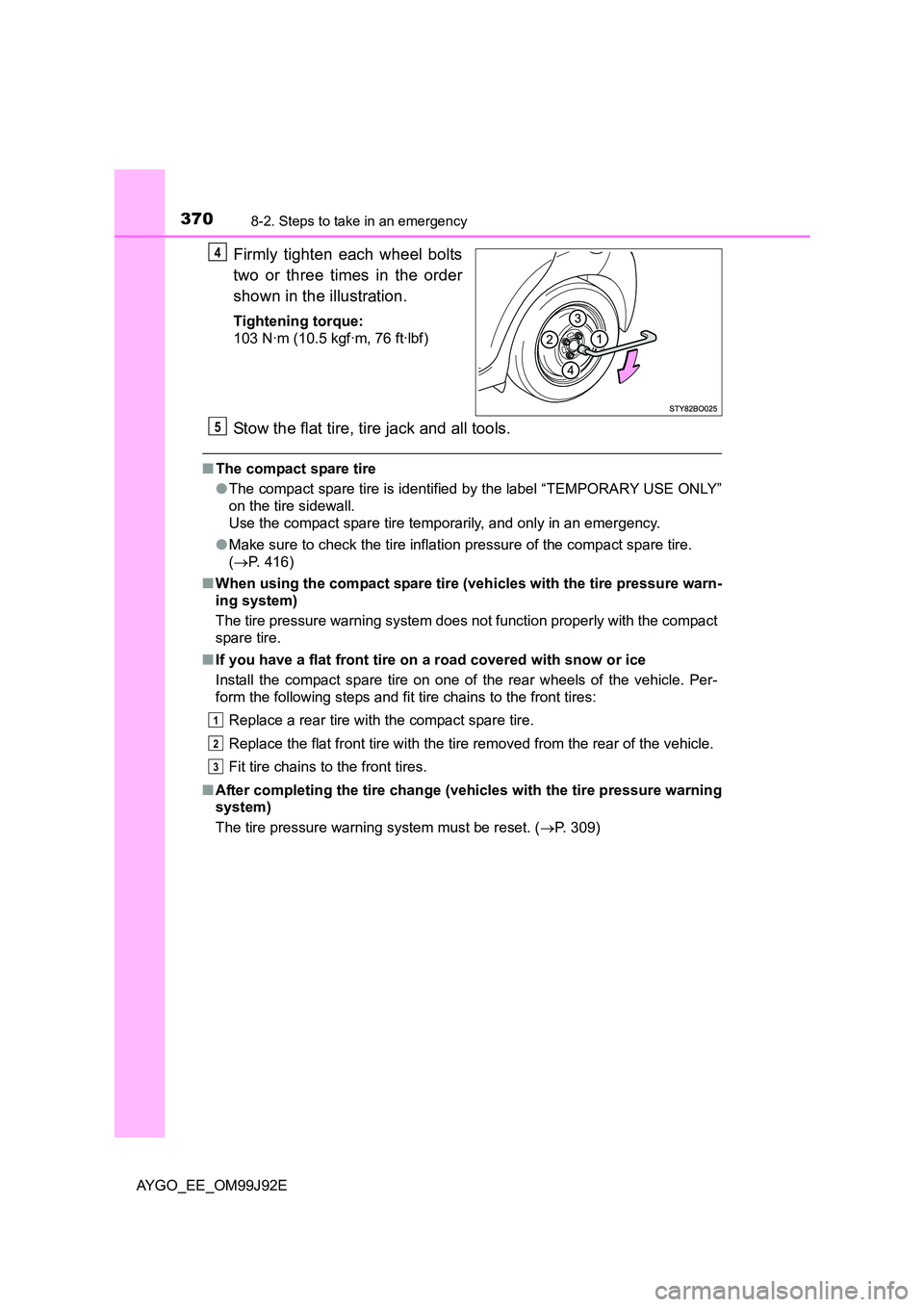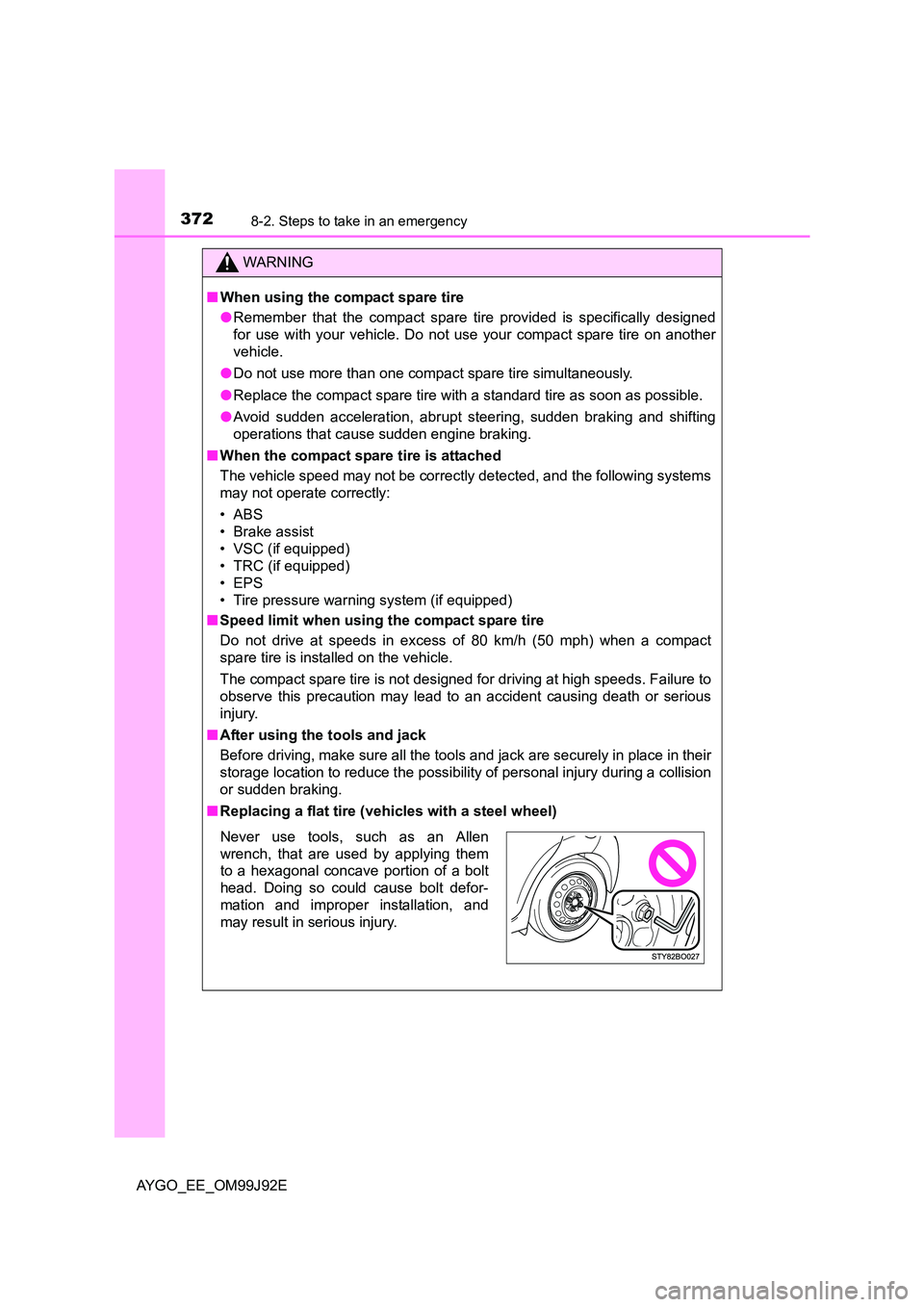Page 315 of 440
3157-3. Do-it-yourself maintenance
7
Maintenance and care
AYGO_EE_OM99J92E
WARNING
■ Proper inflation is critical to save tire performance
Keep your tires properly inflated. Ot herwise, the following conditions may
occur and result in an accident causing death or serious injury:
● Excessive wear
● Uneven wear
● Poor handling
● Possibility of blowouts resulting from overheated tires
● Poor sealing of the tire bead
● Wheel deformation and/or tire separation
● A greater possibility of tire damage from road hazards
NOTICE
■ When inspecting and adjusting tire inflation pressure
Be sure to put the tire valve caps back on.
Without the valve caps, dirt or moisture could get into the valve and cause
air leakage, which could result in an accident. If the caps are lost, replace
them as soon as possible.
Page 356 of 440

3568-2. Steps to take in an emergency
AYGO_EE_OM99J92E
*1: Parking brake engaged warning buzzer:
A buzzer will sound if the vehicle is driven at a speed of approximately
5 km/h (3 mph) or more.
*2: Open door warning buzzer:
A buzzer will sound if the vehicle reaches a speed of 5 km/h (3 mph) or
more with any door open.
*3: Driver’s and passenger’s seat belt buzzer:
The driver’s and passenger’s seat belt buzzer sounds to alert the driver
and passenger that his or her seat belt is not fastened. The buzzer sounds
for 30 seconds after the vehicle reaches a speed of 20 km/h (12 mph).
Then, if the seat belt is still unfastened, the buzzer will sound in a different
tone for 90 more seconds.
*4: Driver’s seat belt reminder light only, on some models
■ To prevent the clutch from overheating (vehicles with a multi-mode man-
ual transmission)
● Do not use the accelerator pedal or starting assist system to hold the vehicle
on a hill.
● On an uphill incline, observe the following whenever possible:
• Maintain a safe distance from the vehicle ahead and avoid unnecessary
starting off and stopping.
• Avoid using E mode on an uphill slope. This will help to avoid unneces-
sary gear changes.
Tire pressure warning light (if equipped)
When the light comes on:
Low tire inflation pressure such as
• Natural causes ( →P. 357)
• Flat tire ( →P. 361, 374)
→ Adjust the tire inflation pressure to the specified level
and carry out initialization.
When the light comes on after blinking for 1 minute:
Malfunction in the tire pressure warning system
→ Have the system checked by any authorized Toyota
dealer or repairer, or another duly qualified and
equipped professional.
Warning lightWarning light/Details/Actions
Page 357 of 440

3578-2. Steps to take in an emergency
8
When trouble arises
AYGO_EE_OM99J92E
■ Front passenger detection sensor, seat belt reminder and warning
buzzer (if equipped)
● If luggage is placed on the front passenger seat, the front passenger detec-
tion sensor may cause the warning light to flash and the warning buzzer to
sound even if a passenger is not sitting in the seat.
● If a cushion is placed on the seat, the sensor may not detect a passenger,
and the warning light may not operate properly.
■ If the malfunction indicator lamp comes on while driving
The malfunction indicator lamp will come on if the fuel tank becomes com-
pletely empty. If the fuel tank is empt y, refuel the vehicle immediately. The
malfunction indicator lamp will go off after several trips.
If the malfunction indicator lamp does not go off, contact any authorized
Toyota dealer or repairer, or another duly qualified and equipped professional
as soon as possible.
■ Electric power steering system warning light (warning buzzer)
When the battery charge becomes insufficient or the voltage temporarily
drops, the electric power steering system warning light may come on and the
warning buzzer may sound.
■ When the tire pressure warning light comes on (vehicles with the tire
pressure warning system)
Inspect the appearance of the tire to check that the tire is not punctured.
If the tire is punctured: →P. 361, 374
If the tire is not punctured:
Check the tire inflation pressure after the tire temperature has lowered suffi-
ciently. Adjust the inflation pressure to the appropriate level and carry out ini-
tialization. ( →P. 310)
■ The tire pressure warning light may come on due to natural causes
(vehicles with the tire pressure warning system)
The tire pressure warning light may come on due to natural causes such as
natural air leaks and tire inflation pressure changes caused by temperature.
In this case, adjusting the tire inflation pressure is at the specified level and
carry out initialization. ( →P. 310)
■ Warning buzzer
In some cases, the buzzer may not be heard because of noisy place or an
audio sound.
Page 358 of 440

3588-2. Steps to take in an emergency
AYGO_EE_OM99J92E
WARNING
■ If both the ABS and the brake system warning lights remain on
Stop your vehicle in a safe place immediately and contact any authorized
Toyota dealer or repairer, or another duly qualified and equipped profes-
sional. The vehicle will become extremely unstable during braking, and the
ABS system may fail, which could cause an accident resulting in death or
serious injury.
■ When the electric power steering system warning light comes on
The steering wheel may become extremely heavy.
If the steering wheel becomes heavier than usual when operating, hold
firmly and operate using more force than usual.
■ If the tire pressure warning light comes on (vehicles with the tire pres-
sure warning system)
Be sure to observe the following precautions. Failure to do so could cause a
loss of vehicle control and result in death or serious injury.
● Stop your vehicle in a safe place as soon as possible. Adjust the tire infla-
tion pressure immediately.
● If the tire pressure warning light comes on even after tire inflation pressure
adjustment, it is probable that you have a flat tire. Check the tires. If a tire
is flat, change it with the spare tire and have the flat tire repaired by the
nearest any authorized Toyota dealer or repairer, or another duly qualified
and equipped professional.
● Avoid abrupt maneuvering and braking. If the vehicle tires deteriorate, you
could lose control of the steering wheel or the brakes.
■ If a blowout or sudden air leakage should occur (vehicles with the tire
pressure warning system)
The tire pressure warning system may not activate immediately.
NOTICE
■ To ensure the tire pressure warning system operates properly (vehi-
cles with the tire pressure warning system)
Do not install tires with different specifications or makers, as the tire pres-
sure warning system may not operate properly.
Page 370 of 440

3708-2. Steps to take in an emergency
AYGO_EE_OM99J92E
Firmly tighten each wheel bolts
two or three times in the order
shown in the illustration.
Tightening torque:
103 N·m (10.5 kgf·m, 76 ft·lbf)
Stow the flat tire, tire jack and all tools.
■ The compact spare tire
● The compact spare tire is identified by the label “TEMPORARY USE ONLY”
on the tire sidewall.
Use the compact spare tire temporarily, and only in an emergency.
● Make sure to check the tire inflation pressure of the compact spare tire.
( →P. 416)
■ When using the compact spare tire (vehicles with the tire pressure warn-
ing system)
The tire pressure warning system does not function properly with the compact
spare tire.
■ If you have a flat front tire on a road covered with snow or ice
Install the compact spare tire on one of the rear wheels of the vehicle. Per-
form the following steps and fit tire chains to the front tires:
Replace a rear tire with the compact spare tire.
Replace the flat front tire with the tire removed from the rear of the vehicle.
Fit tire chains to the front tires.
■ After completing the tire change (vehicles with the tire pressure warning
system)
The tire pressure warning system must be reset. ( →P. 309)
4
5
1
2
3
Page 372 of 440

3728-2. Steps to take in an emergency
AYGO_EE_OM99J92E
WARNING
■ When using the compact spare tire
● Remember that the compact spare tire provided is specifically designed
for use with your vehicle. Do not use your compact spare tire on another
vehicle.
● Do not use more than one compact spare tire simultaneously.
● Replace the compact spare tire with a standard tire as soon as possible.
● Avoid sudden acceleration, abrupt steering, sudden braking and shifting
operations that cause sudden engine braking.
■ When the compact spare tire is attached
The vehicle speed may not be correctly detected, and the following systems
may not operate correctly:
• ABS
• Brake assist
• VSC (if equipped)
• TRC (if equipped)
• EPS
• Tire pressure warning system (if equipped)
■ Speed limit when using the compact spare tire
Do not drive at speeds in excess of 80 km/h (50 mph) when a compact
spare tire is installed on the vehicle.
The compact spare tire is not designed for driving at high speeds. Failure to
observe this precaution may lead to an accident causing death or serious
injury.
■ After using the tools and jack
Before driving, make sure all the tools and jack are securely in place in their
storage location to reduce the possibility of personal injury during a collision
or sudden braking.
■ Replacing a flat tire (vehicles with a steel wheel)
Never use tools, such as an Allen
wrench, that are used by applying them
to a hexagonal concave portion of a bolt
head. Doing so could cause bolt defor-
mation and improper installation, and
may result in serious injury.
Page 376 of 440
3768-2. Steps to take in an emergency
AYGO_EE_OM99J92E
Emergency tire puncture repair kit components
Nozzle
Hose
Compressor switch
Air pressure gauge
Pressure release button
Power plug
Stickers
1
2
3
4
5
6
7
Page 380 of 440
3808-2. Steps to take in an emergency
AYGO_EE_OM99J92E
Make sure that the compressor
switch is off.
Remove the power plug from
the compressor.
Connect the power plug to the
power outlet socket. ( →P. 280)
Check the specified tire inflation
pressure.
Tire inflation pressure is specified
on the label as shown. ( →P. 416)
Start the engine. (→P. 151, 154)
9
10
11
12
13